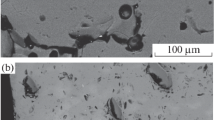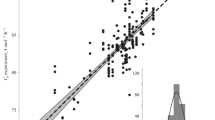Abstract
The surface tension between silicate liquid and gas has been measured for four lava compositions (limburgite to andesite) from 1,200° to 1,500° C. The magnitude of surface tension (γ) is in the range 350–370 dynes/cm. Variations found in γ as a function of liquid composition were small and had no obvious relation to liquid composition. γ was also found to vary little with furnace atmosphere — air, Ar, CO2, H2, CO and their mixtures. A relaxation time of hours to days, depending on temperature, is required before reproducible results can be obtained from originally crystalline starting material.
The reproducible temperature dependence of γ for complex silicate liquid solutions was found to be small, positive, and a relatively simple function of liquid composition. To a first approximation, the dependence of dγ/dT on composition found by King (1953) for simple silicate binaries appears to extend to the complex solutions measured here. The extent of progressive dissociation of liquid constituents implied by the increase of γ with T appears to be principally determined by the average field strength (Z/R) of the network-modifying cations in the liquid and abundance of network-forming constituents \((X_{SiO_2 } )\). The actual amount of structural dissociation implied by these results reduces the molar volume of the average structural unit by at most 5% for a 100° C increase in temperature. Evidently the polymerization of coordination polyhedra is fairly stable over this temperature and composition range.
Similar content being viewed by others
References
Adamson AW (1967) Physical chemistry of surface, 2nd edn, Interscience, NY
Barrett LR, Thomas AG (1959) Surface tension and density measurements on molten glass in the CaO-Al2O3-SiO2 system. J Soc Glass Technol 43:179–190
Bottinga Y, Weill DF (1972) The viscosity of magmatic silicate liquids: a model for calculation. Am J Sci 272:438–475
Hill R Roeder PL (1974) The crystallization of spinel from basaltic liquid as a function of oxygen fugacity. J Geol 82:709–729
Janz GJ, Lorenz MR (1960) Precise measurement of density and surface tension at temperatures up to 1000° C in one apparatus. Rev Sci Instruments 31:18–22
King TB (1951) The surface tension of silicate slags. J Soc Glass Tech 35:241–259
King TB (1953) Anomalies in surface tension of silicates. In: Physical Chemistry of Melts, Inst of Mining and Metallurgy, London
Kingery WD (1959) Surface tension of some liquid oxides and their temperature coefficients. J Am Ceram Soc 42:6–10
McBirney AR, Murase T (1970) Factors governing the formation of pyroclastic rocks. Bull Volcanol 34:372–384
Murase T, McBirney AR (1973) Properties of some common igneous rocks and their melts at high temperature. Geol Soc Am Bull 84:3563–3592
Nelson SA, Carmichael ISE (1979) Partial molar volumes of oxide components in silicate liquids. Contrib Mineral Petrol 71:117–124
Powell MA, Walker D, Hays JF (1980a) Controlled cooling and crystallization of a eucrite: microprobe studies. Proc Lunar Planet Sci Conf 11th, pp 1153–1168
Powell MA, Walker D, Grove TL, Hays JF (1980a) Cation diffusion in basaltic melts: measurements from crystal-liquid boundary layers in controlled cooling experiments. GSA Abstr with Progr 12:502
Shannon RD, Prewitt CT (1969) Effective ionic radii in oxides and fluorides. Acta Crystallogr B25:925–946
Shartsis L, Smock AW (1947) Surface tensions of some optical glasses. J Res Nat Bur Standards 38:241–250 (Res pap 1771)
Shartsis L, Spinner S (1951) Surface tension of molten alkali silicates. J Res Nat Bur Stand 46:385–390 (Res pap 2209)
Shartsis L, Spinner S, Smock AW (1948) Surface tension of compositions in the systems PbO-B2O3 and PbO-SiO2. J Res Nat Bur Stand 40:61–66
Sugden S (1930) The parachor and valency. London
Sparks RSJ (1978) The dynamics of bubble formation and growth in magmas: a review and analysis. J Volcanol Geotherm Res 3:1–37
Walker D, DeLong SE, Shibata T (1979) Crystal-ring microstructures in basalt. EOS 60:409–410
Walker D, Lesher CE, Hays JF (1981) Soret separation of lunar liquids. In: Lunar Planet Sci XII, LPI, Houston
Williams RJ, Mullins O (1976) A system using solid ceramic oxygen electrolyte cells to measure oxygen fugacity in gas mixing systems. NASA Technical memorandum. JSC-09909/NASA TM X-58167
Author information
Authors and Affiliations
Rights and permissions
About this article
Cite this article
Walker, D., Mullins, O. Surface tension of natural silicate melts from 1,200°–1,500° C and implications for melt structure. Contr. Mineral. and Petrol. 76, 455–462 (1981). https://doi.org/10.1007/BF00371487
Received:
Accepted:
Issue Date:
DOI: https://doi.org/10.1007/BF00371487




